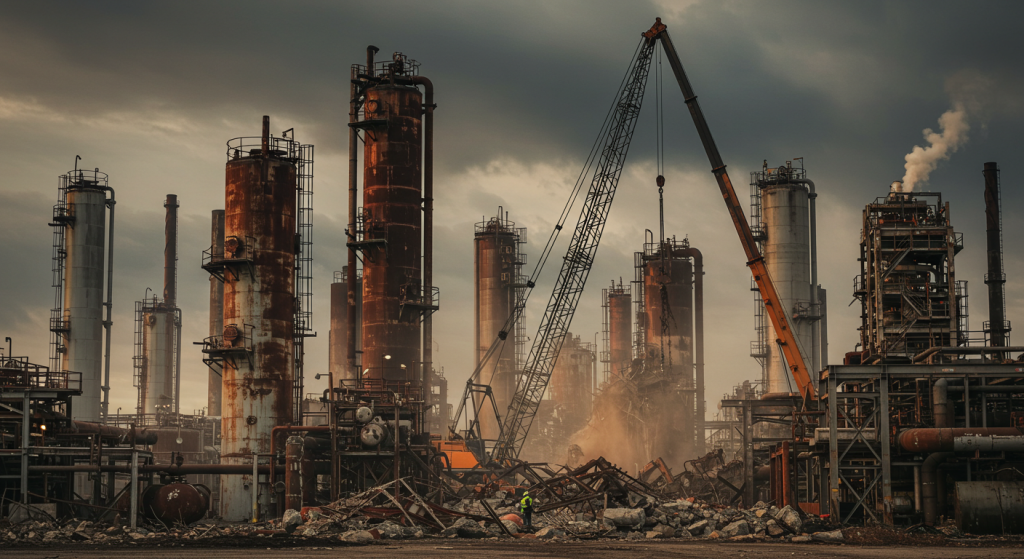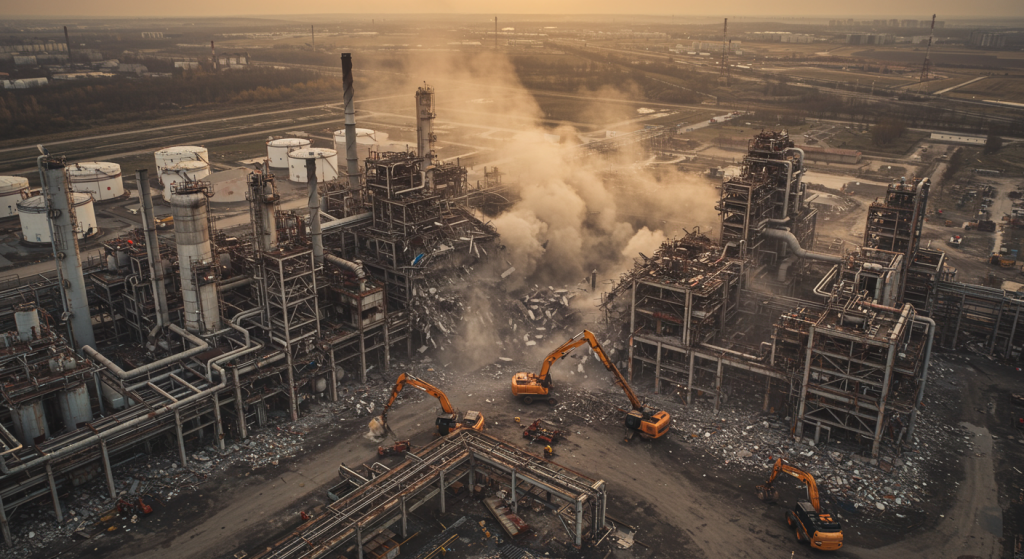How to Arrange Safe & Efficient Oil and Gas Demolition in WA

When old oil rigs, pipelines, or refineries outlive their purpose, the question arrives: what now? There are risky structures, strict safety rules, and a mountain of metal you’re not sure what to do with.
According to Australian law, demolition of oil and gas is the responsibility of refineries. So, you can’t just leave everything in their place, and dismantling is even more risky.
Don’t worry. Scrap metal experts are here for you. We’ll explain the process in detail. So, you can easily arrange a solution that gets the job done safely, sustainably, and without wasting any valuable scrap.
And if you need help in process, West Coast Metals can get you that too.
Based in Perth, we’ve been helping businesses large and small with scrap metal recycling for over two decades. From the first bolt to the last truckload of recyclable metal, we know how to clean the site & turn scrap into real value.
Let’s make you a pro in the process too.
What Is Oil and Gas Demolition?
Oil and Gas Demolition means dismantling all infrastructure tied to a decommissioned oil or gas facility. It involves tearing down platforms, underground pipelines, tanks, wellheads and support structures.
It’s not demolition in the brute force sense. Instead, it’s an orchestrated process that focuses on safe removal, environmental safety, and resource recovery.
This process follows a legally mandated framework. In Australia, regulators like NOPSEMA overlooks the process. It demands immediate infrastructure removal from refineries unless leaving structures in place is safer for the environment and approved in advance.
Decommissioning vs Demolition – Understanding the Difference
These phases overlap and most people confuse them, but they’re sequential.
Decommissioning always comes first, and it safely shuts the operation down. Demolition then follows, removes what’s left, & completes the process. Though separate, they’re tightly linked parts of one workflow.
Decommissioning | Demolition |
Disable the systems & unplug the wells | Physically tears down infrastructure |
Cleans and isolates hazardous parts & chemicals | Cuts, dismantles and transports equipment |
Prepares the site for demolition | Removing structures and site clearing |
Australian law mandates complete clearance involving both these processes. However, certain subsea elements may remain if certified safe, under strict conditions. Regulators demand environment friendly plans and evidence for safety.
Critical Need for Oil & Gas Demolition in WA
According to Petroleum Australia, our country has around 5.7 million tonnes of offshore oil and gas infrastructure set for removal. It is equivalent to 110 Sydney Harbour Bridges. Even more striking, nearly 90% of that mass sits offshore Western Australia.
Approx. 1,000 wells, 57 fixed platforms, 11 floating facilities, and 5,000 km of pipelines need decommissioning. Means WA is staring down the barrel of a colossal teardown over the next 30 years. (Australian Govt Department of Industry, Science & Resourcing)
This is a massive demolition backlog. But, also a huge opportunity to recover tonnes of metal, that can be use in various industries. Then why demolition is getting delayed? Let’s find out some reasons.
Major Challenges in WA Oil and Gas Demolition
It is one of the most tough & critical job as hazardous chemical and giant machinery is involved in it. Challenges include:
Challenge | Details |
Remote & offshore locations | Sites far from port facilities require complex logistics, vessel charters, and planning. |
Limited dismantling hubs | Western Australia currently has few facilities equipped to handle large rig structures or pipelines. Onshore hubs like Ashburton and Onslow are expanding but still under-capacity. |
Skills shortages | The industry lacks enough planners, regulatory experts, recycling specialists, and demolition technicians. |
Tough compliance | Expectations from regulators like NOPSEMA or WA’s DMIRS include comprehensive environment plans, risk reports, and clear timelines. Anyone failing to meet them will face serious penalties or extended liability. |
Let’s guide you on an approach to manage these challenges efficiently.
A Methodical Oil and Gas Demolition Approach
Follow these steps and you’ll get a safe, well-organized, and profitable process out of complex oil and gas demolition.

1. Planning & Project Assessment
Begin years before the site shuts down. According to best practice guidance, operators should plan all decommissioning steps at least five years in advance. Surveys, risk audits, and scrap-metal volume estimates are required before starting the work.
2. Site Preparation & Isolation
It involves:
- Draining tanks and pipelines of oil, gas or fluids.
- Removing insulation, wiring, asbestos and chemicals.
- Disconnecting utilities and erecting safe work zones.
- Documenting barriers, signage and emergency procedures.
This phase minimises spills or worker hazards during dismantling.
3. Plugging & Abandoning Wells
Wells must be sealed permanently to prevent leaks. It is technical and cost-intensive process. You’ll need multi-stage cement plugs tested for durability under pressure. Regulators require full reporting and certified testing documents.
4. Infrastructure Recovery
Use the specialised oil and gas demolition equipment like cranes, shears, cutters & ROVs. So, teams can carefully slice out pipe spools, topsides, jackets and other components. Subsea items require vessels and remote lifts.
All recovered metal is sorted onsite for grade and contamination level.
5. Recycling Scrap Metal
Recovered structures reach shore-based yards, where recycling components like steel, aluminium, brass, copper and stainless steel are separated. Hazardous residue is isolated and disposed of according to regulations.
This step helps you get cash for your debris (compensate for your expenditure) and reduces landfill pressure. You’ll need expert metal recyclers to handle heavy parts.
6. Site Rehabilitation & Closure
Once materials are cleared, the land or seabed is remediated. Activities include backfilling pits, soil or sediment testing, erosion control, and native planting. Final site surveys and environmental reports confirm closure.
Once all conditions are met, regulatory authorities will approve the procedure.
Supporting Factors to Make Process Efficient
Keep these factors in mind too, during the process.
1. Health, Safety & Training
Use trained crews, strict PPE rules, daily hazard briefings, and licensed operators. Past incidents show how subcontractor complexity can increase risk if coordination fails.
2. Community Engagement
Decommissioning near towns or marine parks should involve early stakeholder engagement. Feedback loops and presentation of plans help build trust.
3. Embracing Technology
Modern tools can enhance safety and accuracy during demolition. E.g. drones for mapping, LiDAR scans, robotic cutters, AI risk analysis.
4. Logistics & Facility Planning
WA’s limited onshore capacity means you’ll have to arrange everything in advance. Transport planning, early permits, and efficient port handling can avoid delays & cost spikes.
Why Skipping Proper Demolition is Risky
If you skip any step of the process, overlook any factor or ignore the demolition process altogether, you’ll have to face:
Risk | Detail |
Legal exposure | Leaving infrastructure in place without regulatory approval breaches NOPSEMA and international laws like UN CLOS. |
Environmental hazards | Unsealed wells or failing structures can leak chemicals, pollute soil or marine zones. |
Missed value | Unrecovered scrap metal is lost profit. |
Reputation damage | Companies that mishandle decommissioning face stakeholder & general public backlash. Recently in WA, delays on the Ningaloo Reef RTM tower removal underline this risk. |
Want expert help with your oil and gas demolition project?
Get Perth’s Reliable Recycling & Demolition Support from West Coast Metals
With 20+ years serving scrap metal Perth, we know how WA demolition works.
Our expert team can assist you in planning and recycling scrap metal to handling tonnes of recovered steel, copper, brass and more. We’re a family‑owned, female‑run operation that offer clean yards, friendly service, and practical solutions.
You can get fair prices, simplify logistics, and compliant process.
We’ll sit down over coffee and kick-start your project with confidence and efficiency.

